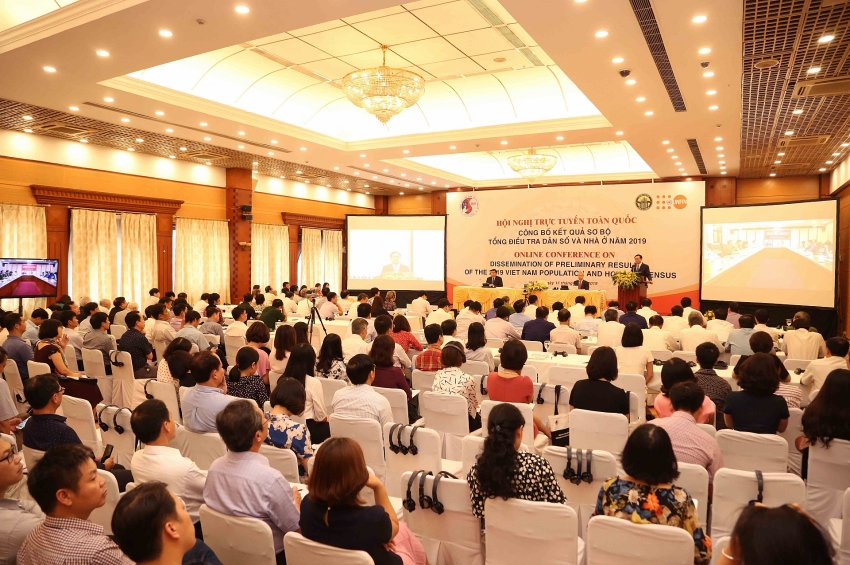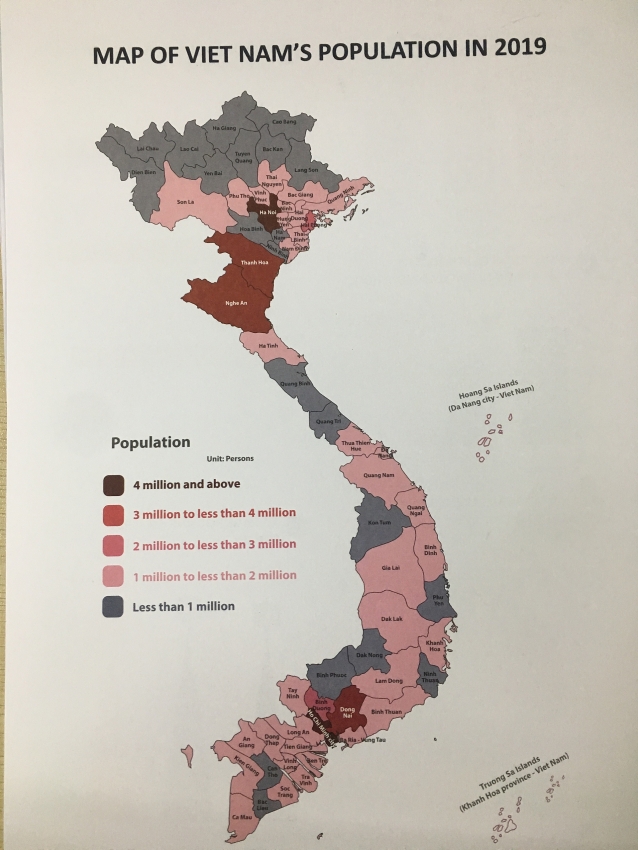Vietnam’s population to reach 96.2 million
 |
| The online conference on the preliminary results of the 2019 Vietnam Population and Housing Census |
On the morning of July 11, 2019, the Ministry of Planning and Investment’s General Statistics Office (GSO) held a conference to disseminate the preliminary results of the 2019 Vietnam Population and Housing Census, which lasted from April 1 to 25, 2019, under the chairmanship of Deputy Prime Minister Vuong Dinh Hue and Minister of Planning and Investment Nguyen Chi Dung.
According to the preliminary results, the total population of Vietnam as of April 1, 2019 was 96,208,984. This makes Vietnam the 15th most populous country in the world and the third most populous country in Southeast Asia, after Indonesia and the Philippines. Compared to 2009, Vietnam’s ranking in Southeast Asia has not changed, though it fell two positions in the worldwide rankings.
The country's population has increased by 10.4 million since 2009. The average annual population growth rate in 2009-2019 was 1.14 per cent, a slight decline compared to the 10 previous years (1.18 per cent).
The sex ratio was 99.1 males per 100 females nationwide, which has continuously increased though it has remained below 100 since the 1979 census.
Vietnam is one of the most densely populated countries regionally and worldwide. The results of the 2019 census revealed that Vietnam's population density is currently 290 persons per sq.km, an increase of 31 persons per sq.km compared to 2009. Hanoi and Ho Chi Minh City have the highest population density in the country, with 2,398 and 4,363 persons per sq.km, respectively.
 |
| Vietnam’s population reached 96.2 million this April |
Rapid and widespread urbanisation in the last decade has sparked urban population growth. Vietnam has 33,059,735 residents in urban areas, accounting for 34.4 per cent of the total population, and 63,149,249 residents in rural areas (65.6 per cent).
As of April 1, 2019, the country had 26,870,079 households, an increase of 4.4 million from 2009. The average annual household growth rate from 2009-2019 was 1.8 per cent, which is the lowest in the last 40 years.
4,800 of these households had no dwellings. This indicator has gradually improved over the last two decades from 6.7 households per 10,000 households in 1999 to 4.7 households in 2009, and 1.8 households at present.
The preliminary results of the 2019 census revealed that the growth rate of the Vietnamese population has increased at a slower pace in the past ten years than it did in the 1999-2009 period. The 2019 census results indicated improved intellectual standards, sharp increases in literacy rates, impressive school attendance rates, and low out of school rates over the last decade.
Vietnam’s efforts to strengthen gender equality have been very successful in recent years, especially in education. Housing conditions have improved significantly, particularly in urban areas over the last ten years. Most households have dwellings and many live in permanent or semi-permanent houses. Per capita housing area has risen considerably, nearly meeting the target stipulated in the National Housing Development Strategy towards 2020 with vision to 2030 issued by the prime minister in accordance with Decision No.2127/QD-TTg dated November 30, 2011.
“The results of the 2019 census indicate the success and efficiency of numerous recent policies. These achievements are attributed to the policies, directions, and guidelines from the Party and the government, and the relentless efforts and belief of each citizen in the process of building and developing the country,” MPI Minister Nguyen Chi Dung stated at the online conference disseminating the preliminary results the 2019 census.
What the stars mean:
★ Poor ★ ★ Promising ★★★ Good ★★★★ Very good ★★★★★ Exceptional
Related Contents
Latest News
More News
- Long-term capital seen as key hurdle to green growth (December 16, 2025 | 08:00)
- HDS Summit spotlights Vietnam’s rising role in regional supply chains (December 16, 2025 | 08:00)
- Agribank frames bank credit as catalyst for green growth (December 15, 2025 | 17:59)
- Legal framework completed for national digital transformation (December 13, 2025 | 21:55)
- SOAR initiative launched at TECHFEST Vietnam 2025 (December 13, 2025 | 10:00)
- Promoting digital assets initiative in Vietnam (December 13, 2025 | 09:30)
- Legislation gives government flexibility for loan guarantees (December 11, 2025 | 18:04)
- Vietnam masters core technologies of automobile value chain (December 11, 2025 | 17:46)
- Japanese investors pursue M&A strategies with long-term vision in Vietnam (December 11, 2025 | 12:14)
- Raising product quality to secure Vietnam’s position in US market (December 11, 2025 | 12:00)

 Tag:
Tag:




























 Mobile Version
Mobile Version